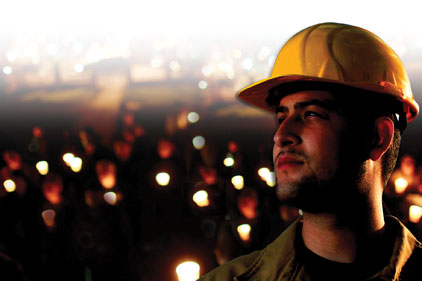Public attitudes about risk are shaped in part by the sense of personal control. In their vehicles, people feel in control. Unless confronted by a drunk driver, which is why driving while under the influence is not tolerated and strictly punished. In an airplane, people have no control, which is why the public would never tolerate 45,000 deaths annually from plane crashes. There is a sense of personal control over the workplace — you can either accept a dangerous job or walk away — missing from the environment (one can’t walk away from air pollution).
"The issue of safety and health in the workplace has never been one of ‘America’s National Worries’ even when there was no OSHA"
“The general public is unconcerned on the entire subject of deaths by accident,” says EHS recruiter Dan Brockman. “Stuff happens. 12 people a day killed in industry, so what? People see the TV program about fishing in boats off Alaska and think nothing of the lives lost every day in that occupation. We kill 40,000 people a year on the highway and no one blinks an eye.”
There are more than three million workplace injuries every year — a stunning, deplorable number that should grab attention. But most are not serious or life threatening. Consider that roughly 11,000 workers suffer amputations every year. Workplace safety and health should be a rallying cry for the more seriously hurt workers and their families. But 94% of all nonfatal amputations involve fingers; 74% of these being amputations of fingertips, according to the Bureau of Labor Statistics. Who hasn’t seen an older carpenter with a missing finger or part of a finger; it’s nothing unusual. It’s not an outrage; it very well can be a badge of honor for the worker.
Worried about the workplace?
The silent national consensus is this: we have reached an acceptable, tolerable level of risk in our workplaces. Yes, too many are still injured and killed, but we don’t live in a perfect world — you will simply never reach zero in seven million workplaces — and you have to make hard choices about national priorities. The media and pols react to public worries, and Gallup shows the public isn’t thinking about worker safety and health.
In a Gallup Poll conducted March 28, 2012, on “American’s National Worries,” here in ranking order is what concerns the public:
- the economy
- gas prices
- Fed spending / budget deficit
- available and affordable healthcare
- unemployment
- social security
- size and power of Fed government
- hunger and homeless
- crime
- drug use
- quality of environment – 37% concerned a great deal
- terrorism
- illegal immigration.
Worker safety and health doesn’t make the top 15 cut. Might not make the top 30. Here are some further reasons why:
1. 70% of workers are satisfied with the health and safety practices of their employer. Only 9% are dissatisfied. (American Psychological Association/Harris Interactive Poll, March 2011)
2. Workplace injuries and illnesses are at an all-time low. Workplace deaths have dropped from 16 per day to 12 per day. There is 30-year trend of declining fatalities. Deaths dropped just as fast from 1933-2005 (points out reporter John Stossel in his new book). Since OSHA’s creation, workplace deaths are down 65 percent. Job-related injuries are down 67 percent.
3. OSHA issues one regulation every 8 years. “OSHA is broken, period,” says Dr. Fulwiler,
4. Corporations have more invested than ever in glossy sustainability reports and corporate social responsibility success stories.
5. Worker safety and health is largely not considered a sustainability issue. “It should be, and I have included the concept in my seminars,” says Fulwiler. “The concept seems to resonate, but we are just very late to the ‘sustainable party’.”
6. Low-hanging hazardous fruit has been plucked. It is costly to improve safety further. “Most of the monsters have been tamed,” says Henry Lick, former director of Ford Motor Company’s industrial hygiene department.
7. Only 30% of the workforce is exposed to physical and chemical hazards of greater intensity or duration than prevalent in the non-work environment, according to Dr. Frank Mirer of Hunter College.
Paying the price
What are the consequences to the EHS profession of the public’s acceptance of workplace injuries and fatalities?
Operating in a maintenance mode. “If it’s true that there is not much societal enthusiasm for further improvements in worker safety, it’s also true that sustaining the safety status quo will require attention, pressure and safety professionals,” says Peter Sandman. “Perhaps the time is coming, in many organizations but obviously not all, when safety maintenance will be a more appropriate goal than perpetual safety improvement.”
Shrinking demand for professionals. “In 1986 companies were willing to pay a 30% recruiter’s fee to hire a certified employee to run a program,” says recruiter Dan Brockman. “In 2012 that is not often the case. Companies will now pay 20% to get someone below $75K that can cover the OSHA rules so the client company won’t get fines.”
“The USA is moving to a service-oriented business model,” says Leemann. “Eventually, we will no longer make stuff. The need for safety and health pros is going to decline precipitously over the coming years.”
Continued use of immigrant workers and secrecy of working conditions in the most dangerous processing plants and with thousands small contractors. According to the AFL-CIO, although the rate of fatal injuries to Latino workers decreased from 4.0 per 100,000 workers in 2009 to 3.7 per 100,000 workers in 2010, the fatality rate among Latino workers was 6 percent higher than that for all U.S. workers. Of the foreign-born workers who were fatally injured at work in 2010, 55 percent were Latino.
Continued lack of transparency by companies that refuse to publicly divulge anything about workplace safety except injury and illness rates and success stories, while investing more and more to publicize sustainability and corporate responsibility commitments and achievements.
No vision from the White House. “For decades now the safety profession has been working without a goal,” says consultant Phil LaDuke. “We have preached the gospel of ‘zero injuries’ even though wiser men from other disciplines have told us such goals were counterproductive. We have embraced fad after fad, lie after lie, and goofball methodology after goofball methodology. Hell, we can’t even agree on a standard definition of the word ‘safety.’
“We have been so remiss in establishing a vision of what exactly constitutes acceptable risk that the public, employers, and government have finally decided for us.”
What can EHS pros do to prevent being marginalized?
“Wake up,” says LaDuke. “The EHS profession needs to look for ways to support and align with operations strategy and to make a real contribution to the bottom line. Safety professionals can make a far greater impact as part of a continuous improvement and productivity enhancement effort than it ever did telling workers to watch their steps and be careful because their kids love them.”
Consultant Tom Lawrence agrees: “OSHA is moving away from basic hazard protection and is pushing into the value-add realm of operational excellence.
“Clean and green is the way to go,” says Andrew Cutz, CIH. We need to find financial incentives to do it, though. How about lower health care premiums?”
“Perhaps safety professionals need to think harder about how to arouse concern, in my terms, ‘outrage’,” says risk communications consultant Dr. Peter Sandman.
“If safety and health pros want to increase their relevance in the workplace now, they need to focus on what they can do to reduce costs and improve productivity,” says Leemann. “Let the PR folks deal with sustainable growth.”
“Advice to the wise,” adds Leemann. “Have an updated passport and be willing to move overseas because that is where the safety and health jobs of the future will be.”
“We need to look in the mirror, step outside the box, and begin to market ourselves just like every other profession does,” says industrial hygienist Aaron Chen. “If you ask people what a doctor, nurse, attorney, police officer, firefighter, chemist, biologist, physicist, teacher, professor, etc, etc. does, most people can easily give you a general idea at least. But poll anyone you meet in a supermarket and ask them if they know what a certified safety professional or certified industrial hygienists does. You get a dull look and response.”
“Don’t cry in your beer,” says safety manager Jack Daugherty. “Rarely has there been recognition of substantial improvements I’ve made. I take satisfaction just knowing that I am doing a good job. That’s what is important; that we do our job, not that anyone notices.”
Hope for a revival of U.S. manufacturing. Manufacturing employment rose from 16 million in 1961 to 21 million in 1979 and then declined to 16 million in 2003 and 11.648 million in November 2010. Manufacturing’s percentage of total employment is down to about 10 percent.
What’s happening now, according to the Boston Consulting Group, is a “reshoring” back to America of manufacturing that previously migrated offshore, especially to China. The analysts estimate that by 2015, China’s cost advantage will have shrunk to the point that many manufacturers will prefer to open plants in the U.S. In about five years, the BCG economists argue, the cost-risk balance will reach a tipping point in favor of the U.S. in seven key industries where manufacturers had been moving to China: computers and electronics, appliances and electrical equipment; furniture; fabricated metals; plastics and rubber; and transportation goods.
“With industry beginning to make a positive turnabout in the U.S., this is a prime time for all of us to market the reasons why we can help make an organization more sustainable with less costs,” says Chen.
Speak up. Secretary of Labor Hilda Solis: “Make your voices heard. Unless you speak up and educate our politicians at the local state and national level, it doesn’t matter who is sitting in the White House, because our opponents will win. And innocent lives will be lost — lives that could have been saved.”
OSHA chief Dr. David Michaels in his Workers’ Memorial Day address: “Ask every candidate for a commitment to safe jobs. Get every one of them on the record supporting worker protections and our effort for a national injury and illness prevention program.”
| Dear Victims of Workplace Fatalities |
| Rockford Greene safety consultant Phil LaDuke has written a blog on a safety pro’s assertion that any workplace fatality is an unacceptable loss. Visit www.ishn.com and click on Random Sampling under the Resources tab at the top of the homepage. |
Embrace transformational leadership. “There are huge gains to be made when enterprises embrace the concept of transformation leadership,” says Fulwiler. “Transformation leadership drives functional excellence not just in safety, but in cost, product, quality, business continuity. This is not smoke and mirrors. I have a number of excellent examples.”
“The days of compliance-driven safety programs is or should be long gone for safety professionals,” says safety manager Mike Kalbaugh. “We need to connect safety improvements with the triple bottom line of people, profit and planet. We should be implementing processes to show how injury prevention impacts the efficient production of high-quality products that drive increases in revenue and meet customer requirements for on-time delivery.
“It all comes down to the corner office,” says Dan Shipp. “Top management has to establish that hazardous exposures, hazardous work practices and hazardous worker behavior will not be tolerated. An EHS professional may be able to sell the boss’s boss on that concept by running the numbers, and there are plenty of head-snapping models that show the effect of a preventable injury on profits. But ultimately it is the boss’s (or owner’s, or shareholders’) commitment to zero, as well as the boss’s conviction that the EHS pro can get the company there and keep it there, that will produce a lasting reduction in injuries and illness from the job.”
LIVE DISCUSSION
Town Hall: Have We Accomplished All We Can in Protecting Workers?
Moderator: Dave Johnson, Editor, ISHN
American Industrial Hygiene Conference & Expo
Tuesday, June 19, 2012
1:30 pm – 3:00 pm
Indianapolis Convention Center, Wabash 2









